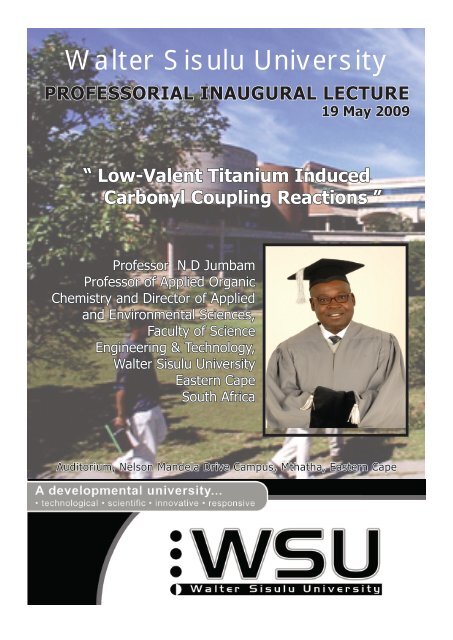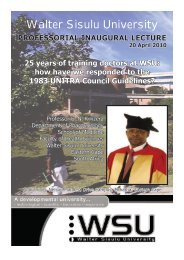Low-Valent Titanium Induced Carbonyl Coupling Reactions
Low-Valent Titanium Induced Carbonyl Coupling Reactions
Low-Valent Titanium Induced Carbonyl Coupling Reactions
Create successful ePaper yourself
Turn your PDF publications into a flip-book with our unique Google optimized e-Paper software.
Walter Sisulu University<br />
PROFESSORIAL INAUGURAL LECTURE<br />
19 May 2009<br />
“ <strong>Low</strong>-<strong>Valent</strong> <strong>Titanium</strong> <strong>Induced</strong><br />
<strong>Carbonyl</strong> <strong>Coupling</strong> <strong>Reactions</strong> ”<br />
Professor N D Jumbam<br />
Professor of Applied Organic<br />
Chemistry and Director of Applied<br />
and Environmental Sciences,<br />
Faculty of Science<br />
Engineering & Technology,<br />
Walter Sisulu University<br />
Eastern Cape<br />
South Africa<br />
Auditorium, Nelson Mandela Drive Campus, Mthatha, Eastern Cape
WALTER SISULU UNIVERSITy (WSU)<br />
FACULTy OF SCIENCE, ENGINEERING ANd TEChNOLOGy<br />
SChOOL OF APPLIEd ANd ENVIRONMENTAL SCIENCES<br />
dEPARTMENT OF ChEMISTRy ANd ChEMICAL<br />
TEChNOLOGy<br />
TOPIC<br />
LOW-VALENT TITANIUM-INdUCEd CARbONyL COUPLING<br />
REACTIONS<br />
by<br />
NdzE dENIS JUMbAM<br />
PROFESSOR OF APPLIEd ORGANIC ChEMISTRy<br />
dATE: 19 MAy 2009<br />
VENUE: WSU AUdITORIUM<br />
3
LOW-VALENT TITANIUM-INdUCEd<br />
CARbONyL COUPLING REACTIONS<br />
The Vice Chancellor,<br />
Deputy Vice Chancellor, Academic Affairs and Research,<br />
Deputy Vice Chancellor, Planning, Quality Assurance and Development<br />
Registrar<br />
Executive Deans of Faculties,<br />
Directors of Schools,<br />
Heads of Departments,<br />
Students,<br />
Members of the University Community and Colleagues,<br />
Distinguished Guests,<br />
Friends,<br />
Ladies and Gentlemen<br />
It is my pleasure to stand here before you to give this inaugural lecture on behalf of the<br />
Department of Chemistry and Chemical Technology in the New School of Applied and<br />
Environmental Sciences. I happen to be the founding Director of this new school which is<br />
located in the Faculty of Science, Engineering and Technology. I feel honoured to present the<br />
first inaugural lecture from my faculty.<br />
My teaching and research interest lies principally in applied chemistry. In this field, I research<br />
and develop new processes as well as improving upon the efficacy of existing ones. I also<br />
have a vested interest in indigenous knowledge systems more particularly natural product<br />
chemistry. This is not surprising given my background in herbal medicine.<br />
For many years I have worked on metal activated reactions in organic synthesis, where the<br />
chemistry of zinc- and silver on graphite was considerably extended. Today I am paying<br />
particular attention to titanium metal, its brief history and the role it has played and continue to<br />
play in carbonyl coupling reactions. I will give an overview of the literature on this, followed<br />
by contributions that I have made alongside other researchers.<br />
1. INTROdUCTION<br />
Interest in the use of low-valent titanium species as reagents in organic synthesis began with<br />
Van Tamelen and his research team in 1965, when they reported the first ever low-valent<br />
titanium-induced reductive dimerization of alcohols to give hydrocarbons [1]. In the early<br />
seventies shortly after the Van Tamelen report, the research teams of Mukaiyama,[2] Tyrlik[3]<br />
and McMurry[4] made the independent and simultaneous discovery that ketones and aldehydes<br />
undergo reductive dimerization to yield olefins on treatment with low-valent titanium reagents.<br />
Particularly McMurry and his co-workers [5,6,7] have extensively investigated this reaction,<br />
5
therefore this process is now generally referred to as the “McMurry reaction” (scheme 1).<br />
6<br />
2<br />
Scheme 1<br />
O<br />
R R'<br />
R, R" = H, alkyl or aryl<br />
"low-valent Ti"<br />
Since its discovery, this reaction has served as an important carbon-carbon bond forming<br />
process and now finds wide applications in organic synthesis.<br />
2. LOW-VALENT TITANIUM REAGENTS<br />
Preparation<br />
Within the area of metal-catalysed reactions, an increasing interest is addressed to the use<br />
of highly active zerovalent metals[8]. The efficiency of these reactions depends on the<br />
active surface area of the metal used, which is a direct function of their degree of dispersion.<br />
Rieke and co-workers[9,10] developed a method for generating metal suspensions by the<br />
reduction of the respective metal salts with an alkali metal in ethereal or hydrocarbon solvents<br />
(scheme 2).<br />
MXn + nK M + nKX<br />
MXn + nK M + nKX<br />
Scheme 2<br />
For most of the reported cases, potassium was used as the reducing agent and THF as the<br />
solvent. Lumps of potassium metal and the respective metal salt were heated in dry THF under<br />
an atmosphere of argon. The reduction was said to be complete within a few hours and the fine<br />
black suspension of the respective metal was produced. In some cases, the alkali metal salt<br />
generated in the reduction was said to have a harmful effect on the desired reactions[9]. Metal<br />
suspensions obtained by the Rieke method represent an important breakthrough in the history<br />
of metal activation. It was this method that offered the possibility of preparing the relatively<br />
active Rieke-titanium by heating titanium trichloride and potassium in THF. One of the greatest<br />
disadvantages of this method is the highly exothermic nature of these reactions which are<br />
liable to run away especially when working with large quantities. Moreover, sintering and<br />
agglomeration of the catalyst is of major concern[11]. The Rieke method, though not without<br />
R<br />
R'<br />
R<br />
R'<br />
+<br />
TiO 2
problems, thus opens up the way for the fine dispersion of metals on various supports. Graphite<br />
is one of the commonly used supports nowadays. It is capable of intercalating foreign atoms,<br />
molecules and even metals[12,13]. The most commonly used potassium-graphite intercalation<br />
reagent C 8 K shows an interlayer distance of 5.3Å[12] and all carbon layers are separated by a<br />
layer of potassium (scheme 3)<br />
Scheme 3<br />
It is now generally accepted that the alkali metal atoms diffuse in the intercalation process from<br />
the periphery of the graphite layers into part or all of the interlayer spacing. The preparation of<br />
the metal-graphite reagents is carried out in two steps:<br />
The generation of the bronze coloured C 8 K[12,14] at 150 0 C under a flow of argon<br />
(scheme 4):<br />
MXn + nK 150 0C, Ar M + nKX<br />
K + 8 C (graphite) C8K Scheme 4<br />
The reduction of the respective metal salt by C 8 K under an atmosphere of argon under reflux<br />
(scheme 5):<br />
MXn + nK M + nKX<br />
n C +<br />
8K MXn C +<br />
8nM n KX<br />
Scheme 5<br />
7
In this way, the metal generated is finely dispersed on the graphite surface layer and is highly<br />
reactive. Thanks to this method, the chemistry of titanium[12] amongst other metals has been<br />
considerably extended.<br />
Despite this progress, a full examination of the literature reveals many ambiguities, be it in the<br />
reaction mechanism, choice of solvent, different reducing agents for titanium salts, selectivity<br />
of product formation, substrate and reagent reactivity, just to name a few. At this stage, the<br />
following is noteworthy:<br />
There is evidence that “Rieke-titanium”[9] suitable for the McMurray reactions, can only<br />
be obtained directly from TiCl 3 . Its reduction is usually carried out by using metals such<br />
asLi[15,16,17], Na[15], K[5,6,15], Mg[3,15], Zn/Cu-couple[6]. The reduction of TiCl 3 with<br />
LiAlH 4 [4,18], or TiCl 4 with any of the above mentioned reducing agents invariably affords<br />
“low-valent titanium” salts[15].<br />
Considering the fact that in some cases the same McMurry procedure is applied to greatly<br />
differing coupling problems there is, in turn, no obvious reason for the various reagent<br />
preparations described for the same type of reduction. This discrepancy is exemplified by<br />
the cyclization procedures used for either diketones[6] or ketoesters[19] by two reagent<br />
combinations as far apart as TiCl 3 /Zn-Cu-couple/THF[6] or TiCl 3 /LiAlH 4 /TEA/DME[19] are<br />
employed despite the completely analogous mechanisms of these reductions[19].<br />
When low-valent titanium reagents are used for pinacolisation[20] reactions, they tend to form<br />
olefinic by-products.<br />
In the reduction of titanium salts by Zn/Cu-couple or LiAlH 4 , the presence of lewis acids had<br />
been found to have an adverse effect[21] on McMurry reactions. The use of triethyl amine<br />
(TEA)[9] in this reaction system might be to neutralize the acid.<br />
The use of C 8 K[22] as the intermediate reducing agent for titanium salts completely avoids the<br />
introduction of the lewis acid species into the reaction system.<br />
The use of sodium-naphthalene[21] as the intermediate reducing agent has been reported to be<br />
a good alternative. However, this method presents a major setback during workup since large<br />
quantities of naphthalene must be separated from the desired product. This can be tedious,<br />
time consuming and can cause reduced yields.<br />
Mechanism of the <strong>Carbonyl</strong> <strong>Coupling</strong> <strong>Reactions</strong><br />
The carbonyl coupling reactions is a two step process viz:<br />
The reductive dimerization of the starting carbonyl compound with formation of the carboncarbon<br />
bond.<br />
8
2<br />
O<br />
R R'<br />
2 x e-<br />
2<br />
O-<br />
R R'<br />
.<br />
Deoxygenation of the titanium pinacolate intermediate to form the corresponding alkene.<br />
R<br />
O-<br />
R'<br />
O-<br />
R<br />
R'<br />
R<br />
R'<br />
The first step is simply a pinacol reaction and is not unique to low-valent titanium. It is<br />
known[23] as far back as1859 that various metals are capable of adding an electron to a carbonyl<br />
carbon atom forming a “ketyl” which subsequently dimerizes. Evidence for this first step in<br />
the titanium-induced coupling reaction is straightforward, since the intermediate pinacols had<br />
been isolated by carrying out the reaction at 0 0 C[24].<br />
R<br />
R<br />
R'<br />
O-<br />
R'<br />
O-<br />
R<br />
R'<br />
9
Table 1. <strong>Titanium</strong>-induced Intramolecular Pinacol <strong>Coupling</strong> <strong>Reactions</strong>[24<br />
Entry Dialdehyde Pinacol Cis/trans ratio Yield (%)<br />
1<br />
2<br />
5<br />
3<br />
4<br />
6<br />
10<br />
CHO<br />
CHO<br />
CHO<br />
CHO<br />
CHO<br />
CHO<br />
CHO<br />
CHO<br />
CHO<br />
CHO<br />
CHO<br />
CHO<br />
OH<br />
OH<br />
OH<br />
OH<br />
OH<br />
OH<br />
OH<br />
OH<br />
OH<br />
OH<br />
OH<br />
OH<br />
100 : 0<br />
25 : 75<br />
70 : 30<br />
25 : 75<br />
5 : 95<br />
30 : 70<br />
Upon treatment of pinacols with active titanium at solvent refluxing temperature, they are<br />
readily deoxygenated to yield the corresponding alkene. The reaction follows an intermolecular<br />
pathway on monocarbonyl compounds to yield acyclic alkenes and on high dilution an<br />
intramolecular pathway on dicarbonyl compounds to yield cycloalkenes[25]. As substrates,<br />
dialdehydes, diketones and ketoaldehydes can be used.<br />
In the process of the alkene formation, the two C-O bonds do not appear to break at the<br />
same time and a mixture of cis- and trans-alkenes is produced starting from a diol of known<br />
stereochemistry[24]. Furthermore, the two oxygen atoms of the pinacol must be able to<br />
approach and bond to the titanium surface. Thus, the cis isomer of 9,10-decalindiol reacts<br />
smoothly with low-valent titanium to yield the anticipated olefin but the trans isomer does not<br />
react even on prolonged treatment. The two oxygens of the cis isomer are in close proximity<br />
while does of the trans are prevented by the steric hindrance from coming in contact with the<br />
titanium surface.<br />
85<br />
80<br />
82<br />
75<br />
83<br />
89
OH CH3 OH CH3 1<br />
OH<br />
OH<br />
2<br />
=<br />
=<br />
HO<br />
OH<br />
OH<br />
OH<br />
Ti<br />
Ti<br />
No reaction<br />
3. InterMOLECULAR COUPLING OF ALdEhydES ANd KETONES<br />
3.1 Synthesis of Alkenes<br />
In his effort to develop an alternative process to Wolff-Kishner reaction, McMurry and his<br />
team[7] subjected enone (4) to TiCl 3 /LiAlH 4 and to their surprise, obtained a hydrocarbon, not<br />
the one they anticipated but a reductively dimerized triene (5) in 80% yield.<br />
O<br />
4<br />
CH 3<br />
TiCl 3/LiAlH 4<br />
While McMurry was not alone at the time in making this fundamental discovery[2,3], he was<br />
however, quick to ascertain the potential of his discovery and embarked on exploring the scope<br />
of the new reaction. He soon realised that the reductive coupling reaction was not limited to<br />
α,β-unsaturated ketones but was general for all kinds of ketones and aldehydes and that the<br />
titanium reagent did not isomerize olefin geometry[7].<br />
CH 3<br />
5<br />
3<br />
CH 3<br />
80 %<br />
11
Dimestrole (7), a precursor of diethylstilbestrol is readily prepared from the ketone (6)[5,6]<br />
O<br />
6<br />
12<br />
OMe<br />
CH 3<br />
TiCl 3/LiAlH 4/THF<br />
95 %<br />
MeO<br />
3.1.1 Synthesis of Strained Alkenes<br />
7<br />
CH 3<br />
C<br />
H 3<br />
The coupling of ketones with low-valent titanium reagent to form alkenes is generally effective<br />
for simple ketones. In sterically hindered ketones, however, the yields are generally low (table<br />
2) and alternative synthetic routes have been unsuccessful for some of these compounds.<br />
OMe
Table 2. Synthesis of Strained Olefins[24]<br />
Entry Substrate Product<br />
1<br />
2<br />
3<br />
4<br />
5<br />
6<br />
O<br />
O<br />
O<br />
O<br />
O<br />
O<br />
To date the synthesis of tetra-tert-butylethylene remains elusive!<br />
O<br />
Ti[<br />
Ref.<br />
26, 27<br />
31<br />
28<br />
29<br />
30<br />
32<br />
13
3.1.2 Mixed <strong>Carbonyl</strong> <strong>Coupling</strong> <strong>Reactions</strong><br />
Intermolecular carbonyl coupling reactions are usually limited to the preparation of symmetrical<br />
olefins by the reductive dimerization of a ketone or an aldehyde. A mixture of two different<br />
carbonyl compounds will react generally to a nearly statistical mixture of olefins when subjected<br />
to low-valent titanium[33,34]. For the purposes of synthesis, such mixed couplings are only<br />
useful only if one component is used in excess and if the products are easily separable[24].<br />
For example, mixed coupling of acetone with a chiral α,β-unsaturated ketones like (R)-(-)-<br />
(4-methylcyclohexylidene)acetone affords a diene (9)initially prepared by Walborsky for<br />
chiroptical study[35].<br />
C<br />
H 3<br />
14<br />
8<br />
C<br />
H 3<br />
H<br />
O<br />
+<br />
C<br />
H 3<br />
O<br />
TiCl 4/LiAlH 4<br />
CH 3<br />
C<br />
H 3<br />
C<br />
H 3<br />
Another example of a mixed coupling reaction is the reaction of an equimolar amount of 2,6dimethyl-2-cyclohexenone<br />
(10) and formyl(trimethylsilyl)cyclopropane (11) with low-valent<br />
titanium. Paquette[36] prepared sesquiterpene vetispirene (12) by this method with a yield of<br />
60%. There is however, no apparent justification why the mixed product should be so strongly<br />
favoured over the symmetrical products in this case.<br />
C<br />
H 3<br />
10<br />
O<br />
CH 3<br />
+<br />
11<br />
SiMe 3<br />
CHO<br />
TiCl 3/Zn-Cu<br />
60 %<br />
9<br />
CH 3<br />
CH 3<br />
C<br />
H 3<br />
H<br />
SiMe 3<br />
Mixed carbonyl coupling reaction has paved the way for the synthesis of the antitumor agent<br />
tamoxifen (15) and several of its analogs[37,38].<br />
12<br />
CH 3
CH 3<br />
13<br />
O<br />
+<br />
O<br />
X R<br />
14<br />
3.1.3 Functional Group Compatibility<br />
R = OCH 2CH 2NMe 2<br />
C<br />
H 3<br />
X R<br />
15<br />
X = H, Tamoxifen<br />
Several easily reducible functional groups do not survive in the presence of low-valent titanium<br />
due to the strong reducing potential of this reagent.<br />
Acetal. Not many carbony coupling reactions are known to take place in the presence of<br />
acetal groups[]. Clive reported[39] the coupling of acetal (16) in the course of compactin (17)<br />
synthesis.<br />
OHC<br />
OSMDBT<br />
16<br />
OSiEt 3<br />
O<br />
O<br />
O<br />
CH 3<br />
CH 3<br />
CH 3<br />
TiCl 3/C 8K<br />
85 %<br />
OSMDBT<br />
OSiEt 3<br />
17<br />
O<br />
O<br />
CH 3<br />
8 %<br />
CH 3<br />
CH 3<br />
15
Alcohol. There are hardly any cases of carbonyl coupling reactions in the presence of free<br />
alcohols. While saturated alcohols like in cholesterol are unaffected by low-valent titanium,<br />
allylic alcohols however, undergo reductive coupling[40].<br />
18<br />
16<br />
OH<br />
<strong>Low</strong>-valent titanium<br />
Alkene. Alkenes are unaffected by low-valent titanium, and an array of carbonyl coupling<br />
reactions have been carried out in the presence of carbon-carbon double bonds. Compound<br />
(21) a natural product was synthesized from the unsaturated keto-aldehyde (20) without any<br />
evidence of double bond isomerization[41]<br />
C<br />
H 2<br />
CH 3<br />
20<br />
CHO<br />
CH 3<br />
O<br />
CH 3<br />
19<br />
TiCl 3/Zn-Cu/DME<br />
Alkyl silane. Paquette’s successful coupling of formyl(trimethylsilyl)cyclopropane[42]<br />
indicates that tetraalkylsilanes appear to be inert towards low-valent titanium.<br />
SiMe 3<br />
TiCl 3/Li<br />
SiMe 3<br />
CHO SiMe 3<br />
11 22<br />
C<br />
H 3<br />
21<br />
C<br />
H 3<br />
CH 3<br />
CH 2
Amines. Amines are inert towards low-valent titanium and have been added in some reactions<br />
to improve yields[43].<br />
OHC<br />
N<br />
H<br />
23<br />
N<br />
H<br />
CHO<br />
TiCl 3/Zn<br />
3%<br />
Ether. All types of ethers are compatible to low-valent titanium. THF, DME and benzyl<br />
ethers[44] are used as solvents in these reactions without any reported adverse effects. Even<br />
silyl ethers are compatible[45].<br />
Halides. Halides substituted on aromatic nucleus appear to be compatible as illustrated by this<br />
example[46].<br />
Br<br />
CH 3<br />
O<br />
TiCl 3/Li<br />
25 26<br />
Br<br />
Sulfide. Not many cases have been reported and no problems were encountered with the<br />
following example[47].<br />
O<br />
27<br />
S<br />
O<br />
TiCl 4/Zn<br />
N<br />
H<br />
H<br />
N<br />
CH 3<br />
24<br />
CH 3<br />
N<br />
H<br />
H<br />
N<br />
S<br />
28<br />
Br<br />
67 %<br />
17
Amide. Although amides have been reported to react slowly with low-valent titanium<br />
reagents[24] Castedo[48] demonstrated a mixed coupling of an aldeydro urethane (29) with<br />
benzaldehyde.<br />
MeO<br />
MeO CHO<br />
18<br />
+<br />
29<br />
CHO<br />
Me<br />
N<br />
TiCl 3/Li<br />
COOEt<br />
MeO<br />
MeO<br />
Me<br />
N COOEt<br />
Ester.Various carbonyl coupling reactions have taken place in the presence of esters.<br />
Intermolecular coupling is usually the most successful[49]and intramolecular coupling is<br />
only successful when it involves the formation of five- or six-membered rings[50].<br />
MeO<br />
AcO<br />
31<br />
C<br />
H 3<br />
33<br />
CH 3<br />
CH 3<br />
O<br />
O<br />
CHO<br />
TiCl 3/Zn/Cu<br />
COOMe<br />
MeO<br />
AcO<br />
TiCl 3/Zn/Cu<br />
C<br />
H 3<br />
30<br />
CH 3<br />
32<br />
CH 3<br />
CH 3<br />
34<br />
OAc<br />
OMe<br />
COOMe<br />
55%<br />
52<br />
97
Ketone. Ketones do in fact survive ketone-coupling reaction if in an intramolecular cyclization<br />
leading to a five- or six-membered ring occurs rapidly enough so that the reaction can be<br />
quenched before competing intermolecular dimerization reaction sets in[24]. This is clearly<br />
demonstrated by Ziegler in the total synthesis of an estrone (35 → 36)[51].<br />
MeO<br />
35<br />
OHC<br />
O<br />
C<br />
H 3<br />
H<br />
O<br />
TiCl 3/Zn/Ag<br />
MeO<br />
Nitrile. Although nitriles were predicted to react slowly with low-valent titanium[52], a recent<br />
report[53] demonstrates its participation in an intramolecular cyclization reaction<br />
.<br />
CN<br />
NH<br />
O<br />
O<br />
TiCl 3/Zn<br />
37 38<br />
Toluenesulfonate. Unsuccessful attempts have been made to reduce sulfones with low-valent<br />
titanium[54]. There is only one reported case of an intermolecular carbonyl coupling reaction<br />
in the presence of a tosylate group[49].<br />
OTs<br />
39<br />
O<br />
CH 3<br />
C<br />
H 3<br />
OTs<br />
CH 3<br />
OTs<br />
36<br />
NH 2<br />
N<br />
H<br />
TiCl 3/Zn/Cu 80%<br />
40<br />
O<br />
H<br />
86%<br />
56 %<br />
CH 3<br />
O<br />
19
4. INTRAMOLECULAR CARbONyL COUPLING REACTIONS<br />
The importance of titanium-induced carbonyl coupling reactions to synthetic organic chemists<br />
cannot be over emphasized. The formation in good yields of a plethora of rings of various<br />
sizes and shapes that otherwise would have been quite difficult to prepare is testimony thereof.<br />
Cycloalkanes and many natural products have been readily prepared. These reactions require<br />
high dilution in order to achieve intramolecular cyclization rather than intermolecular<br />
polymerization. Some examples of intramolecular coupling of diketones are shown in table<br />
3.<br />
20
Table 3. Intramolecular Dicarbinyl <strong>Coupling</strong><br />
Entry Substrate Product Ref.<br />
1<br />
2<br />
3<br />
4<br />
5<br />
6<br />
7<br />
8<br />
O<br />
H<br />
O<br />
O O<br />
O<br />
O<br />
O O<br />
O<br />
O<br />
S<br />
O<br />
O<br />
O<br />
O O<br />
5. INTRAMOLECULAR KETO ESTER COUPLINGS<br />
1.1 Synthesis of Cyclic Ketones<br />
H<br />
O<br />
H<br />
S<br />
H<br />
55, 56<br />
55<br />
55<br />
55<br />
57<br />
47<br />
58, 59<br />
The examples described thus far have to do with either ketones or aldehydes or both. The<br />
carbonyl coupling reaction has found an interesting extension to ketoester cyclization[19,60].<br />
The mechanism of this reaction is claimed to be the exact analogue of the dicarbonyl coupling<br />
60<br />
21
eaction[19]. Thus, an assumed initial pinacol-type reaction forms the carbon-carbon bond,<br />
followed by deoxygention to yield an enol ether. Acid hydrolysis affords the final cyclanone<br />
product (scheme 6). Evidence for this proposed mechanism comes from the fact that the enol<br />
ether has been isolated[19], by excluding the acidic conditions during workup.<br />
Scheme 6<br />
This reaction has paved the way for the synthesis of cycloalkanones of medium- to large-ring<br />
sizes which otherwise would be difficult to get. <strong>Titanium</strong>-induced synthesis of cyclononenone<br />
(42) illustrates the importance of this process[60].<br />
C<br />
H 3<br />
O<br />
22<br />
41<br />
CH 3<br />
CH 3<br />
COOCH 2CH 3<br />
C<br />
H 3<br />
C<br />
H 3<br />
6. SyNThESIS OF hETEROCyCLIC COMPOUNdS<br />
6.1 Preparation of Furans<br />
Further extension of the ketoester cyclization to the closely related acyloxycarbonyl compounds<br />
was envisaged to afford products with the enol ether forming part of the heterocyclic ring<br />
system (scheme 7).<br />
O<br />
42<br />
CH 3<br />
91%
Scheme 7<br />
Keto-enol tautomerism[63] is common to carbonyl compounds containing an α-hydrogen.<br />
Although the conversion of a carbonyl compound to its tautomer is not generally a preparative<br />
procedure, these reactions do have their preparative aspects. With a trace of acid or base,<br />
the tautomeric equilibrium state can be considerably influenced[64]. Thus 1,3-dicarbonyly<br />
compounds (43) and (44) were acylated under standard conditions to substrates (43a), (44a),<br />
and (44c) which on treatment with titanium/graphite in refluxing THF afforded the anticipated<br />
furans (table 4)[65]. The instability of 2-methyl-3,5-diphenylfuran (44b) already reported[66]<br />
appears to be characteristic of this compound. It decomposed immediately on attempted<br />
workup.<br />
Table 4. <strong>Titanium</strong> <strong>Induced</strong> Synthesis of Furans<br />
R 3<br />
O<br />
R 1<br />
43a<br />
44a<br />
44c<br />
O<br />
O<br />
R 1 R 2 R 3<br />
Me Me Ph<br />
Ph Ph Me<br />
Ph Ph Ph<br />
R 2<br />
Ti/Graphite<br />
THF or DME<br />
43b<br />
44b<br />
44d<br />
R 1<br />
O<br />
Me Me Ph<br />
Ph Ph Me<br />
Ph Ph Ph<br />
R 2<br />
R 3<br />
R 1 R 2 R 3 Yield %<br />
a decomposed on attempted workup<br />
58<br />
a<br />
92<br />
23
On subjecting O-benzoylbenzoin (45a) and O-acetylbenzoin (45b) to low-valent titanium,<br />
instead of the anticipated oxeten derivatives, these compounds were spontaneously deoxygenated<br />
affording deoxybenzoin (45d) in good yields (table 5)[67].<br />
24<br />
Table 5. Deoxygenation of Benzoin and its Derivatives by <strong>Low</strong>-<strong>Valent</strong> <strong>Titanium</strong><br />
OR<br />
O<br />
Substrate R<br />
45a<br />
45b<br />
45c<br />
Bz<br />
Ac<br />
H<br />
Ti/Graphite<br />
THF or DME<br />
O<br />
Product % Yield<br />
A closer look at the literature[18] revealed that α-hydroxyketones and cyanohydrins were<br />
deoxygenated on treatment with low-valent titanium. To verify this information, benzoin (45c)<br />
was treated with titanium/graphite and it did deoxygenate forming the anticipated deoxybenzoin<br />
(45d).<br />
1.2 Preparation of Benzofurans<br />
Benzofuran ring systems are present in many natural and synthetic products which show<br />
pharmacodynamic properties[67]. Some fully unsaturated benzofurans occur naturally, such<br />
as the simple 5-methoxybenzofuran (46), which exhibits bactericidal properties[68].<br />
MeO<br />
46<br />
O<br />
The efficiency of the ketoester cyclization paved the way for the extension of the reaction to<br />
the synthesis of benzofurans[65,68,69,70]]. The results of varied types of benzofurans are<br />
listed on table 6.<br />
45d<br />
45d<br />
45d<br />
89<br />
92<br />
80
R 1<br />
47<br />
O<br />
O<br />
O R 2<br />
Ti/Graphite<br />
THF, reflux<br />
R1 R2 R<br />
Method Yield %<br />
Ph Ph<br />
Ph Me<br />
Me Ph<br />
Me<br />
R<br />
Table 6. Synthesis of benzofuran derivatives using low-valent titanium reagents [70]<br />
Me<br />
Me Ph<br />
4-OMe<br />
Me Ph<br />
A<br />
A<br />
A<br />
R<br />
48<br />
O<br />
R 1<br />
Ph B 5<br />
H<br />
3-MeOPh H<br />
B<br />
5-OMe<br />
Me Ph 6-OMe B<br />
Me Ph 4 , 5 - (OMe) 2 B 24<br />
Me Me H<br />
A [d]<br />
H<br />
H<br />
H<br />
Me<br />
Ph H<br />
A 89<br />
3-MeOPh 4-OMe A [d]<br />
A = Ti-graphite, THF, reflux B = TiCl 4/Zn/dioxane, reflux<br />
H<br />
H<br />
H<br />
H<br />
1.3 Synthesis of Coumarins<br />
B<br />
B<br />
A<br />
8<br />
85<br />
80<br />
60<br />
45<br />
56<br />
58<br />
[d]<br />
R 2<br />
[d] = decomposed<br />
A set of suitable substrates 49a – c was prepared by the acylation of commercially available<br />
α- hydroxyaryl ketones or hydroxyaryl esters with different α-ketoacid chlorides under<br />
standard conditions. However, only moderate yields were obtained due largely to the low<br />
nucleophilicity of the phenolic –OH and of partial hydrolysis of the esters 49a –c during<br />
column chromatography.<br />
On treatment of the esters 49a,b with low-valent titanium generated by reducing TiCl 3 with<br />
zinc dust in refluxing THF, afforded the coumarins 50a and 50b in good yields (table 7)[53].<br />
25
26<br />
Table 7. Synthesis of Coumarins Mediated by <strong>Low</strong>-<strong>Valent</strong> <strong>Titanium</strong><br />
R 1<br />
Substrate<br />
49a<br />
49b<br />
O<br />
R 1<br />
O<br />
O<br />
O<br />
Me Me<br />
Me Ph<br />
49c OMe Ph<br />
R 2<br />
R 2<br />
c<br />
Product<br />
50a<br />
50b<br />
c<br />
R 1<br />
R 2<br />
O O<br />
R 1<br />
R 2<br />
Me Me<br />
Me<br />
Ph<br />
= methyl 2-hydroxybenzoate<br />
Yield (%)<br />
The treatment of the ester 49c resulted in hydrolysis of the ketoester and formation of the<br />
parent compound methyl 2-hydroxybenzoate.<br />
Furthermore, compound 51 on treatment with low-valent titanium afforded 4-amino-3phenylcoumarin<br />
52 without difficulty.<br />
CN<br />
O<br />
O<br />
TiCl 3/Zn<br />
THF, reflux<br />
NH 2<br />
O<br />
51 52<br />
Although the examples listed for the synthesis of coumarins are few in number, they do however,<br />
indicate the potential of producing coumarins by this method and should be explored.<br />
6.4 <strong>Titanium</strong>-induced synthesis of Indoles<br />
So far the titanium-induced ketoester cyclization paved the way for the extension of the reaction<br />
to encompass the synthesis of furans, benzofurans and coumarins. Although carboxylic acid<br />
amides were considered inert towards low-valent titanium reactions[24] a new entry into<br />
O<br />
O<br />
80<br />
76<br />
85%
the synthesis of indoles from acylamidocarbonyl compounds has proved remarkable for the<br />
synthesis of indoles[65,67,70]. For example, the high-dilution technique[24] commonly used<br />
in cyclization reactions is now unnecessary. The formation of indoles takes place readily, even<br />
at high concentrations without evidence of intermolecular coupling reactions competing. All<br />
amides ranging from formamide up to fatty acid amides, including aromatic and heteroaromatic<br />
ones, undergo comparatively rapid reactions affording anticipated indoles in good to excellent<br />
yields. The results of some of the titanium-induced indole formation are listed in table 8.<br />
Table<br />
R 1<br />
53<br />
O<br />
O<br />
NH R 2<br />
TiCl 3/Zn<br />
THF, reflux<br />
R1 R Yield (%)<br />
2 R1 R2 Yield (%)<br />
Me Ph<br />
Me Me<br />
Ph<br />
Ph<br />
Ph Me<br />
Ph<br />
Ph<br />
H<br />
(CH 2) 14 CH 3<br />
Ph<br />
Ph t - Bu<br />
Me H<br />
75<br />
70<br />
90<br />
87<br />
H 92<br />
92<br />
90<br />
84<br />
69<br />
Ph<br />
Thiophenyl -<br />
Ph m-FPh<br />
Ph p-ClPh<br />
Ph m - BrPh<br />
Ph<br />
Ph<br />
Ph<br />
Ph<br />
Ph<br />
p- IPh<br />
m-MeOPh<br />
p-F3CPh<br />
p-NCPh<br />
HC = CHPh<br />
54<br />
N<br />
H<br />
R 1<br />
79<br />
94<br />
86<br />
81<br />
80<br />
86<br />
83<br />
76<br />
68<br />
R 2<br />
[b] together with 2,3-diphenylindole (< 10%)<br />
The indole synthesis (table 8) illustrates not only the ease with which these products are<br />
formed but it also underscores the functional group compatibility in the presence of low-valent<br />
titanium. Furthermore, steric hinderance does not seem to feature prominently in this indole<br />
synthesis given the fact that substrate (cf. Table 8, R 1 = Ph, R 2 = t-Bu) is easily transformed<br />
to the desired product. The synthesis of tricylic skeletal framework can be illustrated by the<br />
reactions (55) to (57) and (58) to (59)[67].<br />
27
28<br />
O<br />
55<br />
O<br />
O<br />
O<br />
NH OEt<br />
Ph<br />
N<br />
O<br />
O<br />
Ti/Graphite , DME<br />
Ti/Graphite, DME<br />
58 59<br />
56<br />
57<br />
N<br />
H<br />
O<br />
N<br />
Ph<br />
O<br />
NaH, THF<br />
The indole synthesis also exhibits a striking chemoselectivity thereby putting into question the<br />
known bias of different carbonyl groups engaging readily in reductive coupling reactions. The<br />
chemoselectivity can best be illustrated by the synthesis of salvadoricine (61)[71] a simple<br />
indole isolated from Savadora persica and widely used in Pakistan as a drug.<br />
N<br />
Ph<br />
O<br />
61%<br />
79<br />
78<br />
OEt
60<br />
C<br />
H 3<br />
NH<br />
O<br />
O<br />
O<br />
Ti/Graphite in DME<br />
CH 3<br />
Several aspects of this chemoselective transformation are worth mentioning:<br />
• The observation, that a keto-amide coupling completely overcomes both inter- as well<br />
as intra-molecular diketone coupling is in sharp contrast to earlier reports[24,34] on<br />
low-valent titanium coupling reactions;<br />
• This reaction pathway is even more surprising given the fact that an intramolecular<br />
diketone coupling would have provided a well known and stable 3,4-dimethyl-2(1H)quinolone;<br />
• High dilution are unnecessary for the formation of indoles[65,67];<br />
• Owing to the short reaction times the remaining ketone in (61) perfectly resists subsequent<br />
intermolecular coupling although an excess of the low-valent titanium reagent is present<br />
in the reaction system;<br />
In accordance with this result, the trifunctional substrate (62) and (63), obtained from<br />
commercially available 5-chloro-2-aminobenzophenone and ethyl oxalyl chloride, formed<br />
indoles (64) and (65) in 93 and 94% isolated yield, respectively[71].<br />
61<br />
N<br />
H<br />
CH 3<br />
CH 3<br />
N<br />
H<br />
O<br />
CH 3<br />
61 %<br />
CH 3<br />
O<br />
29
Cl<br />
30<br />
ph<br />
N<br />
R<br />
O<br />
O<br />
O<br />
Cl<br />
Ti/Graphite<br />
OET<br />
62: R = H<br />
i i<br />
63: R = Me<br />
i: NaH, MeI, THF<br />
N<br />
H<br />
ph<br />
64: R = H (93%)<br />
65: R = Me (94%)<br />
66: R = CH2CN<br />
ii: NaH, ClCH2CN<br />
In this case, no inconveniences due to the adjacent ester group were encountered, although<br />
titanium-induced cyclization of oxoalkanoates are well established in the literature[19,61,72,73].<br />
While indole (65) is a precursor for diazepam[74], alkylation of the nitrogen atom in compound<br />
(64) with chloroacetonitrile afforded indole (66) being structurally related to precursors for<br />
serotonin and histamine antagonists[75]. With this new approach to the indole nucleus by<br />
closure of the C2 – C3 bond, the synthesis of zindoxifen (67a), known to be strongly tumorinhibiting,<br />
and a series of structural analogues (67b – d) of this pharmacologically important<br />
compound was made possible[76].<br />
O<br />
OET<br />
Cl<br />
Cl<br />
ph<br />
C<br />
H 3<br />
N<br />
N<br />
Ph<br />
N<br />
O<br />
NH
R 1<br />
R 2<br />
N<br />
CH 3<br />
Table 9. <strong>Titanium</strong> induced synthesis of zindoxifen and analogues<br />
R 4<br />
R 1 R 2 R 3 R 4<br />
67a OAc H OAc Et<br />
67b OH H OH Et<br />
67c OH OH OH Me<br />
67d<br />
OMe OMe OMe Me<br />
1.5 Synthesis of 2-Quinolones<br />
68<br />
R 1<br />
NH<br />
O<br />
O<br />
O<br />
R 2<br />
TiCl 3/Zn<br />
THF , reflux<br />
Table 10. <strong>Low</strong>-valent titanium induced 2-quinolone synthesis<br />
Entry Yield (%)<br />
1<br />
2<br />
R 1 R2<br />
H<br />
R 3<br />
Me Ph 80<br />
3 Ph Ph 68<br />
4 Ph Me 69<br />
5 Me 2-Thienyl 50<br />
6 OMe OH 41<br />
Ph<br />
64<br />
69<br />
R 1<br />
N<br />
H<br />
R 2<br />
O<br />
31
The acylation of 2-aminobenzonitrile with phenylglyoxylic acid chloride gave rise to the ester<br />
(37) which on treatment with low-valent titanium gave rise to 2-amino-3-phenyly-2-quinolone<br />
(38) in moderate yield[53].<br />
32<br />
37<br />
CN<br />
NH<br />
O<br />
O<br />
Ph<br />
TiCl 3/Zn<br />
THF , reflux<br />
38<br />
NH 2<br />
N<br />
H<br />
Ph<br />
O<br />
45 %
7. CONCLUSION<br />
Almost any of the organic or organoelement compounds can be synthesized by a choice of<br />
several different methods, but for a given compound there usually will be a preferred reaction,<br />
depending on such factors as yield, convenience, economy and ease of purification of the<br />
product. In the field of metal-catalyzed reactions, the efficiency of the reactions depends on the<br />
active surface area of the metal used which is a direct function of their degree of dispersion.<br />
The high demand for efficiency, no longer met by the classical methods, has brought further<br />
impetus in the development of metal activation.<br />
The primary aim of this work has been the development of a methodological strategy of using<br />
highly active metal reagents and in particular titanium. The progress achieved by the use of<br />
these reagents, shows how misleading the strange conviction often held, that certain reactions<br />
were “worked out”, in the sense of being complete and understood.<br />
The carbonyl coupling reactions has evolved since its inception in the early seventies. The<br />
reaction now finds applications in the synthesis of an array of products ranging from strained<br />
olefins to all kinds of unusual molecules and natural products. Further expansion of the reaction<br />
to the synthesis of varied heterocyclic molecules (such as furans, benzofurans, coumarins,<br />
quinolones and indoles) as described herein, signify a major lip forward but by no means the<br />
end of the road for titanium in organic synthesis.<br />
33
REFERENCES<br />
1. E, E. van Tamelen, B. Akermark, K. B Sharpless, J. Am. Chem. Soc. 1969, 91, 1552.<br />
2. T. Mukaiyama, T. Sato, J. Hanna, Chem. Lett. 1973, 1041.<br />
3. S. Tyrlik, I. Wolochowicz, Bull. Soc. Chim. Fr. 1973, 2147.<br />
4. J. E. McMurry, M. P. Flemming, J. Am. Chem. Soc. 1974, 96, 4708.<br />
5. J. E. McMurry, M. P. Flemming, J. Org. Chem. 1976, 41, 896.<br />
6. J. E. McMurry, M. P. Flemming, K. L. Kees, L. R. Krepski, J. Org. Chem. 1978, 43,<br />
3255.<br />
7. J. E. McMurry, Acc. Chem. Res. 1983, 16, 405.<br />
8. S. C. Davis, K. J. Klabunde, Chem. Rev., 1982, 82, 153.<br />
9. R. D. Rieke, Top Current Chem., 1975, 59, 1.<br />
10. R. D. Rieke, Acc. Chem. Res., 1977, 10, 301.<br />
11. K. J. Klabunde, T. O. Murdock, J. Org. Chem., 1979, 44, 3901.<br />
12. R. Csuk, B.I. Glaenzer, A. Fuerstner, Adv. Organomet. Chem., 1988, 28, 85.<br />
13. H. F. Klein, Kontakte (Merck), 1982, 3, 3.<br />
14. D. Savoia, C. Trombini, A. U-Ronchi, Pure Appl. Chem., 1985, 57, 1887.<br />
15. R. Dams, M. Malinowski, I Westdorp, H. Y. Geise, J. Org. Chem., 1982, 47, 248.<br />
16. J. E. Pauw, A. C. Weedon, Tetrahedron Lett., 1982, 5485.<br />
17. S. Huenig, B. Ort, Liebigs Ann. Chem., 1984, 1905.<br />
18.<br />
34<br />
J. E. McMurry, M. G. Silvestri, M. P. Flemming, T. Hoz, M. W. Grayston, J. Org. Chem.,<br />
1978, 43, 3249.<br />
19. J. E. McMurry, D. D. Miller, J. Am. Chem. Soc. 1983, 105, 1660.
20. B. P. Mundy, R. Srinivasa, Y. Kim, T. Dolph, R. J. Warnet, J. Org. Chem., 1982, 47,<br />
1657.<br />
21.<br />
22.<br />
D. L. J. Clive, C. Zhang, K. S. K. Murthy, W. D. Hayward, S. Daigneault, J. Org. Chem.,<br />
J. Org. Chem., 1991, 56, 6447.<br />
G. P. Boldrini, D. Savoia, E. Tagliavini, C. Trombini, A. U-Ronchi, J.<br />
Organomet. Chem., 1985, 280, 307.<br />
23. R. Fittig, Liebigs Ann. Chem., 1859, 110, 23<br />
24. J. E McMurry, Chem. Rev., 1989, 89, 1513.<br />
25. J. E. McMurry, Acc. Chem. Res., 1983, 16, 405.<br />
26. D. S. Bomse, T. H. Morton, Tetrahedron Lett., 1975, 781.<br />
27.<br />
R. F. Langer, T. T. Tidwell, Tetrahedron Lett., 1977, 777.<br />
28. D. Lenoir, Chem. Ber., 1978, 111, 411.<br />
29. D. Lenoir, D. Malwitz, B. Meyer, Tetrahedron Lett., 1984, 25, 2965.<br />
30. D. Lenoir, P. Lemmen, Chem. Ber., 1980, 13, 3112.<br />
31. D. Lenoir, H. Burghard, J. Chem. Res(S), 1980, 396.<br />
32. H. Wenck, A. de Meijere, F. Gerson, R. Gleiter, Angew. Chem. Int. Ed. Engl. 1986, 25,<br />
335.<br />
33. J. E. McMurry, L. R. Krepski, J. Org. Chem., 1976, 41, 3929.<br />
34. D. Lenoir, Synthesis, 1989, No.12, 883.<br />
35. S. M. Reddy, M. Duraisamy, H. M. Walborsky, J. Org. Chem. 1986, 51, 2361.<br />
36. L. A. Paquette, T.-H. Yan, G. J. Wells, J. Org. Chem., 1984, 49, 3610.<br />
37. P. L. Coe, C. E. Scriven, J. Chem. Soc., Perkin Trans. 1., 1986, 475.<br />
38. J. Shani, A. Grazit, T. Livshitz, S. Brian, J. Med. Chem. 1985, 28, 1504.<br />
35
39.<br />
36<br />
D. L. J. Clive, K. S. K. Murthy, A. G. H. Wee, J. S. Prasad, G. V. J. daSilva, M.<br />
Majewski, P. C. Anderson, R. D. Haugen, L. D. Heerze, J. Am. Chem. Soc. 1988,<br />
110, 6914.<br />
40. J. E. McMurry, M. Silvestri, J. Org. Chem., 1975, 40, 2687.<br />
41. J. E. McMurry, P. Kocovsky, Tetrahedron Lett., 1985, 26, 2171.<br />
42. L. A. Paquette, G. J. Wells, G. J. Wickham, J. Org. Chem. 1984, 49, 3618.<br />
43. A. Ishida, T. Mukaiyama, Chem. Lett., 1976, 1127.<br />
44. L. Castedo, J. M. Saa, R. Suau, G. Tojo, Tetrahedron Lett., 1983, 24, 5419.<br />
45. G. Pattendon, G. M. Robertson, Tetrahedron Lett., 1986, 27, 399.<br />
46. W. H. Richardson, Synth. Commun., 1981, 11, 895.<br />
47. J. Nakayama, H. Machida, R. Saito, M. Hoshino, Tetrahedron Lett., 1985, 26, 1981.<br />
48.<br />
J. A. Seijas, A. R. deLera, M. C. Villaverde, L. Castedo, J. Chem. Soc. Chem. Commun.,<br />
1985, 839.<br />
49. L. Castedo, R. Suau, G. Tojo, J. Org. Chem. 1981, 46, 4292.<br />
50.<br />
D. T. Witiak, P. L. Kamat, D. L. Allison, S. M. Liebowitz, R. Glaser, J. E. Holliday, M.<br />
L. Moeschberger, P. J. Schaller, J. Med. Chem. 1983, 26, 1679.<br />
51. F. E. Ziegler, H. J. Lim, J. Org. Chem., 1982, 47, 5229.<br />
52. R. Dams, M. Malinowski, H. J. Geise, J. Recl. Trav. Chim. Pays-Bas, 1982, 101, 112.<br />
53. A. Fuerstner, N. D. Jumbam, N. Shi, Z. Naturforsch. 1995, 50b, 326.<br />
54.<br />
N. D. Jumbam. Unpublished results.<br />
55. A. L. Baumstark, C. J. McCloskey, K. E. Witt, J. Org. Chem., 1978, 43, 3609.<br />
56.<br />
J. E. McMurry, K. L. Kees, J. Org. Chem. 1977, 42, 2655.<br />
57. J.-M. Pons, M. Santelli, Tetrahedron, 1988, 44, 4295.
58.<br />
59.<br />
60.<br />
J. E. McMurry, G. J. Haley, J. R. Matz, J. C. Clardy, G. van Duyne, R. Gleiter, W.<br />
Schaefer, D. H. White, J. Am. Chem. Soc., 1984, 106, 5018.<br />
J. E. McMurry, G. J. Haley, J. R. Matz, J. C. Clardy, G. van Duyne, R. Gleiter, W.<br />
Schaefer, D. H. White, J. Am. Chem. Soc., 1986, 108, 2932.<br />
J. E. McMurry, R. Swenson, Tetrahedron Lett., 1987, 28, 3209.<br />
61. J. E. McMurry, D. D. Miller, Tetrahedron Lette., 1983, 1885.<br />
62. M. Iyoda, T. Kushida, S. Kitami, M. Oda, J. Chem. Soc., Chem. Commun., 1987,<br />
1607.<br />
63.<br />
rd J. March, Adv. Organic Chemistry, 3 Ed., Wiley, New York, 1985.<br />
64. P. Y. Bruice, T. C. Bruice, J. Am. Che. Soc., 1976, 98, 844.<br />
65. A. Fuerstner, N. D. Jumbam, H. Weidmann, Tetrahedron Lett., 1991, 32, No.46, 6695.<br />
66. G. Rio, A. Lecas-Nawrocka, Bull. Soc. Chim. Fr., 1974, 12, 2824.<br />
67. A. Fuerstner, N. D. Jumbam, Tetrahdron, 1992, 48, No.29, 5991.<br />
68.<br />
T. L. Gilchrist, Heterocyclic Chemistry, Longman, 1998.<br />
69. A. Banerji, S. K. Nayak, J. Chem. Soc. Chem. Commun., 1990, 150.<br />
70. A. Fuerstner, Angew. Chem. Int. Ed. Engl. 1993, 32, 164.<br />
71. A. Fuerstner, N. D. Jumbam, J. Chem. Soc. Chem. Commun., 1993, 211.<br />
72. A. Fuerstner, H. Weidmann, Synthesis, 1987, 1071.<br />
73. A. Fuerstner, R. Csuk, C. Rohrer, H. Weidmann, J. Chem. Soc., Perkin Trans., 1. 1988,<br />
1729.<br />
74. H. Yamamoto, S. Inaba, T. Hirohashi, K. Ishizumi, Chem. Ber., 1968, 101, 4245.<br />
S. B. Rajur, A. Y. Merwade, S. B. Hendi, L. D. Basanagouda, Ind. J. Chem.,<br />
75. 1989, 28B,<br />
1065.<br />
37
76.<br />
38<br />
A. Fuerstner, N. D. Jumbam, unpublished results; for the pharmacology of<br />
2-phenylindoles, see for example E. von Angerer, J. Prekajac, J Strohmeier, J. Med.<br />
Chem. 1984, 27, 1439.
ACKNOWLEdGEMENT<br />
I would like to thank Walter Sisulu University for according me the opportunity to continue to<br />
serve in different capacities in this university. I would also like to thank the entire management<br />
team, particularly the Vice Chancellor of the University, Professor M Balintulo for his able<br />
leadership; the Deputy Vice Chancellor for Academic Affairs and Research, Professor C L<br />
Obi for creating a conducive academic and research environment; Special thanks go to my<br />
Executive Dean of the Faculty of Science, Engineering and Technology Professor S P Songca,<br />
whom I have known and worked with for more than ten years; the Director of Research<br />
Development, Professor G Ekosse for his organisational skills and support leading up to this<br />
occasion, members of the WSU community, and the community of Mthatha who have accepted<br />
and treated me as one of their own.<br />
I also would like to thank FSET School Directors (Professor S Mishra, Dr C Marsh, Mrs T<br />
Mandindi and Mr F Gerber), whom through regular planning and management meetings I<br />
have come to know more closely and not only appreciate them for their dedication to duty but<br />
also for their sense of humour and friendship.<br />
Special thanks go to my students, who have worked tirelessly with me. I wish you well in your<br />
future career endeavours. I recognise the presence of my colleagues from the Department of<br />
Chemistry and Chemical Technology. You have housed me over the years and continue to do<br />
so. While we all come from legacy institutions, the strength of our institution lies in unity and<br />
our department is not any different.<br />
Many thanks go to my friends who have come from far away to be here and listen to me speak.<br />
I recognise the presence of Professor and Mrs Asrat Tegaye, Dr Phakiso Mokhahlane and Dr<br />
Demetrio Benetello. I thank you sincerely for your efforts and wish you a safe journey back to<br />
your families and loved ones.<br />
I am always mesmerized by the WSU choir when and wherever I here them sing. Today is no<br />
different, and I thank you from the bottom of my heart.<br />
I remember with deep appreciation, the love and care I received from my parents, who are now<br />
of blessed memory. I try hard to do the same to my own family. At this juncture I would like to<br />
thank my trusted, loving and faithful spouse here present, Genet Kibret Asnake, for her care,<br />
support and wisdom without which this entire struggle will not be possible or worthwhile. Our<br />
dear sons Mathias- and Kenjo Jumbam could not be here with us because they are at school.<br />
Our daughter Keafon Ranissi Jumbam could not be here also due to work commitments.<br />
Mr Vice Chancellor Sir, Ladies and Gentlemen,<br />
I Thank You.<br />
39
CITATION FOR PROFESSOR N d JUMbAM<br />
Professor Ndze Denis Jumbam was born in 1956 to Mr Mathias Jumbam and Lucella Labe<br />
Jumbam in Shisong-Nso, in the highlands of the interior of West Cameroon. He is the last born<br />
in a family of seven brothers and one sister. He trained as a Herbalist under the mentorship<br />
of his father and village traditional healers. He qualified and was licenced in 1976 by the<br />
Traditional Healers Association of Cameroon.<br />
After completing high school in 1976 he left for Northern Nigeria where he worked for two<br />
years as a teacher in St. Peters Junior Seminary. He joined the University of Freiburg in 1978<br />
in Switzerland where he learned German and started his academic career as a chemist. He left<br />
for Germany in 1985, where he trained at the Technical University of Leuna Merseburg as<br />
a Process Chemist. He did a postgraduate degree in Industrial Management at the Technical<br />
University of Berlin. He then moved to Austria where he did a Ph.D in Industrial Organic<br />
Chemistry at the Technical University of Graz. During this time, he also did a Postgraduate<br />
degree in Environmental Protection Technology.<br />
He returned to Germany in 1991 where he worked as a research scientist in Max-Planck Insitute<br />
for Coal Research. He joined the University of Zimbabwe as a lecturer in 1994 and later the<br />
University of Transkei in March 1998 as a Senior Lecturer. He worked in this University as<br />
Deputy Dean of the Faculty of Science from 1999 to 2002 and as acting Head of Department<br />
of Chemistry from 2003 to 2006. He was promoted to Professor of Chemistry in 2007 and<br />
later appointed as Director of School of Applied and Environmental Sciences in January<br />
2009, a position he holds to date. Professor Jumbam has a wealth of experience in supervising<br />
postgraduate students, has attended national and international conferences and published in<br />
peer reviewed journals.<br />
Professor Jumbam is married and has three children.<br />
40
44<br />
Design: Mthatha Health Resource Centre










